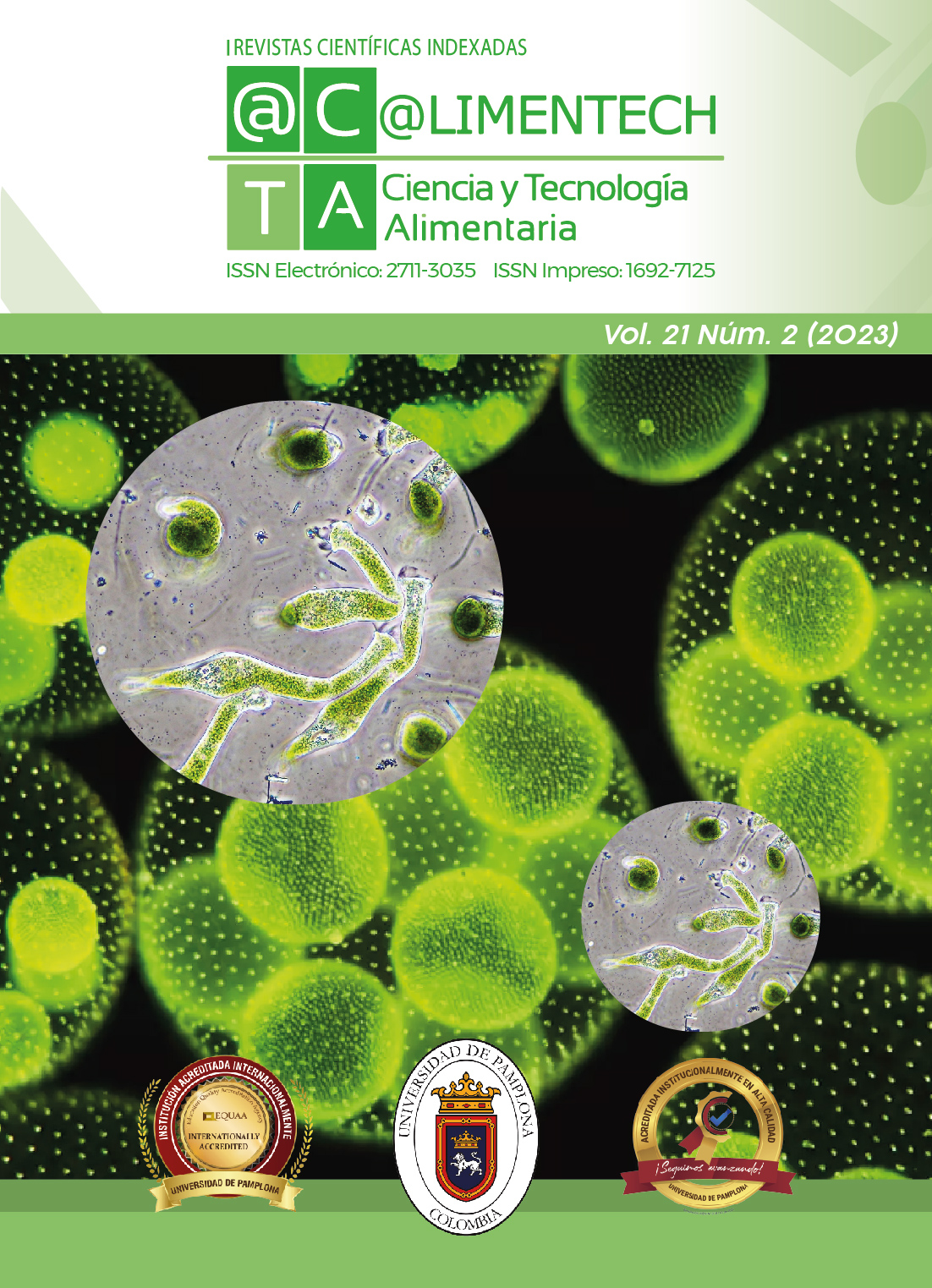Use of the air-lift phytoreactor, from chlorella vulgaris microalgae, for removal of organic matter in urban waste waters
DOI:
https://doi.org/10.24054/limentech.v21i2.2792Keywords:
Wastewater, microalgae, Chlorella vulgaris, air-lift photobioreactorAbstract
The environmental impact generated in natural water ecosystems by the discharge of wastewater produces eutrophication; which is the excessive growth of algae, due to the presence of high concentrations of salts. Therefore, in this investigation it was proposed to evaluate two strains of the Chlorella vulgaris microalgae (native and UTEX1803) and two concentrations of each (20 and 30%), for the removal of nutrients using urban wastewater from the municipality of Pamplona, North Santander. Initially, the physicochemical evaluation of urban wastewater was carried out. A concentric tube air-lift photobioreactor was designed, using the operating air flow a volumetric O2 kLa mass transfer coefficient of 67.68h -1, mixing time of 5.303 ± 0.0153 s and retention of gas in the reactor of 0.0219. In the start-up of the bioreactor for the removal of nutrients, the inoculums of the strains were determined in order to adapt them to the new substrate, by increasing cell growth. The 30% inoculum removal was 95% NO3 and 83.3% PO4 for the native strain and for the UTEX 1803 strain 92.5 and 91.2% for NO3 and PO4 respectively.
Downloads
References
Andrade, C., Chacón, C., Cárdenas, C., & Morales, E. (2006). Remoción de nitrógeno y fósforo de aguas residuales urbanas por la microalga Chlorella sp. en condiciones de laboratorio. CIENCIA, 14, 58-63.
Arias, C. (2015). Evaluación preliminar de la remoción de nitrógeno total y ortofosfato de aguas residuales por Chlorella sp., en un fotobiorreactor air-lift (Tesis de pregrado). Universidad de Pamplona, Pamplona, Colombia.
Cartagena, C., & Malo, O. (2017). Evaluación del uso de la microalga Chlorella vulgaris en la remoción de materia orgánica de las aguas residuales de la PTAR EL SALITRE a nivel laboratorio (Tesis de pregrado). Fundación Universidad de América, Bogotá D.C, Colombia.
Chisti, M. (1989). Airlift Biorreactors. Elsevier.
Contreras, A., García, F., Molina, E., & Merchuk, J. (1998). Interaction between CO2-mass transfer, light availability, and hydrodynamic stress in the growth of Phaeodactylum tricornutum in a concentric tube photobiorreactor. Biotechnology and Bioengineering, 60, 317-325.
Cortés, F., Rubio, D., & Gómez, E. (2013). Análisis comparativo de modelos hidrodinámicos y cinéticos para fotobiorreactores airlift. ITECKNE, 10, 57-66.
Craggs, R., Smith, V., & McAuley, P. (1995). Wastewater nutrient removal by marine microalgae cultured under ambient conditions in mini-ponds. Water Science and Technology, 31, 151-160.
Diaz, V., & Ordoñez, C. (2006). Evaluación del pH y la agitación del medio más adecuada para el crecimiento de dunadiella salina en condiciones de laboratorio (Tesis de pregrado). Pontificia Universidad Javeriana, Bogotá, Colombia.
Kumar, M., Miao, Z., & Wyatt, S. (2010). Influence of nutrient loads, feeding frequency and inoculum source on growth of Chlorella vulgaris in digested piggery effluent culture medium. Bioresource Technology, 101, 6012-6018.
Lazcano Carreño, C. (2016). Biotecnología ambiental de aguas y aguas residuales. Ecoe Ediciones.
Luo, L., Liu, F., Xu, Y., & Yuan, J. (2011). Hydrodynamics and mass transfer characteristics in an internal loop airlift reactor with different spargers. Chemical Engineering Journal, 175, 494-504.
Martínez, E., Sánchez, S., Jimenez, J., Yousfi, F., & Muñoz, L. (2000). Nitrogen and phosphorus removal from urban wastewater by the microalga Scenedesmus obliquus. Bioresource Technology, 73, 263-272.
Olarte, E., & Valencia, M. (2016). Evaluación del uso de la microalga Chlorella vulgaris en el tratamiento de aguas residuales industriales (VINAZAS) (Tesis de pregrado). Universidad Nacional Abierta y a Distancia, Colombia.
Pouliot, Y., Buelna, G., Racine, C., & De la Noüe, J. (1989). Culture of cyanobacteria for tertiary wastewater treatment and biomass production. Biological Wastes, 29, 81-91.
Rodríguez, L., Gómez, L., & Peraza, Y. (2014). Evaluación del crecimiento de Chlorella vulgaris en diferentes concentraciones de vinaza. Centro Azúcar, 41, 75-85.
Salazar, M. (2005). Aplicación e importancia de las microalgas en el tratamiento de aguas residuales. Laboratorio de Microbiología y Tratamiento de Aguas Residuales, Universidad Autónoma de México.
Sánchez, Y., Reyna, R., Aguilar, R., Torres, G., & Rodríguez, R. (2016). Tratamiento fúngico de un agua residual municipal en un reactor air-lift de circulación interna. ResearchGate.
Valderrama, T., Del Campo, M., Rodríguez, M., Bashan, E., & Bashan, Y. (2002). Treatment of recalcitrant wastewater from ethanol and citric acid production using the microalga Chlorella vulgaris and the macrophyte Lemna minuscula. Water Research, 36, 4185-4192.
Velasco, H. (2009). An airlift continuous bioreactor for high-rate treatment of domestic sewage. New Biotechnology, 25, 197-198.
Velasco, Y., Muñoz, M., Ramírez, J., Otero, A., Medina, V., & Cruz, P. (2011). Efecto del medio de cultivo sobre el crecimiento y el contenido proteico de Chlorella vulgaris. Rccp Revista Colombiana de Ciencias Pecuarias, 25, 438-449.
Wang, J., & Zhong, J. (2001). Bioprocessing for value-added products from renewable resources. Elsevier Science, 131-161.
Wong, J., Wong, Y., & Tam, N. (2000). Nickel biosorption by two Chlorella species, C. vulgaris (a commercial species) and C. miniata (a local isolate). Bioresource Technology, 73, 133-137.
Downloads
Published
How to Cite
Issue
Section
License
Copyright (c) 2023 @limentech, Ciencia y Tecnología Alimentaria

This work is licensed under a Creative Commons Attribution-NonCommercial 4.0 International License.








